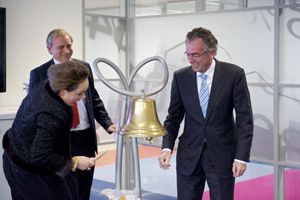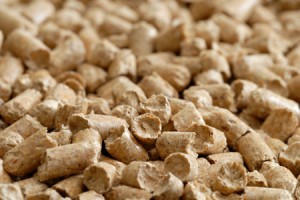Dutch launch world's first biomass exchange
on
Power and gas exchange APX-Endex branches out into wood pellets
Dutch launch world's first biomass exchange
The Dutch power and gas exchange APX-Endex has opened the world's first Biomass Exchange in Amsterdam. The new Exchange will serve as a platform for trade in standardized industrial wood pellets, which are increasingly used as a renewable alternative for coal in coal-fired power stations. 'We hope that our Exchange will bring long-term security and stability to this growing market', says Pieter Schuurs, COO of APX-Endex.
 |
| Alexandra van Huffelen, alderman of the city of Rotterdam, and Mark Dierikx, Director-General Energy of the Dutch Ministry of Economic Affairs, inaugurate the APX-Endex Biomass Exchange under the watchful eye of Bert den Ouden, CEO of APX-Endex (photo: APX-ENDEX) |
It is 6 to 12 mm in diameter, has a maximum length of 4 cm, a maximum water content of 10%, a net calorific value of 17 MJ (megajoules) per kg and a minimum density of 600 kg/m3. It does not contain additives nor is it chemically treated. Its colour: brownish. In fact, it looks a bit like a piece of dried cat food. Meet: the standardized wood pellet. From now on, it can be traded on the world’s first Biomass Exchange, launched on Thursday by the Dutch gas and power exchange APX-Endex in cooperation with the Port of Rotterdam.
Wood pellets were first used in industrial power and heating facilities at the time of the oil crises in the 1970s, but when oil prices declined in subsequent years, they virtually disappeared from the market. Lately, however, they have been making a comeback, thanks to various government support schemes for renewable energy. According to the Annual Statistical Report 2011 from the European Biomass Association (AEBIOM), consumption of pellets in the EU27 steadily increased from 3.8 million tons in 2005 to 9.8 million tons last year. Production grew from 2.6 million tons in 2005 to 9.2 million tons in 2010. Production capacity in the EU has tripled over the last five years to 14.8 million tons. Imports stood at 2.5 million tons in 2010.
Analysts expect the wood pellet market to show continued strong growth in the coming years. The major exporting countries, the US, Canada and Russia, are expanding their production. They are also getting more competition from countries like Brasil, where, for example, eucalyptus trees are grown especially for wood pellet production, and various countries in Africa. Meanwhile, European power producers like RWE are ramping up their investments in processing capacity, for example in the UK.
Overly optimistic
Europe is by far the most important market for wood pellets. Last year, worldwide production was some 13 million tons, of which roughly 80% was consumed in Europe. Some expect the market to grow to over 100 million tons by 2020, but Paul Groes, Account Manager Derivatives at APX-Endex, who has
| 'Coal costs about $80 a ton, pellets trade at around €135 per ton. And coal has a higher calorific value' |
Pellets are popular in electricity production because they are extremely dense and have a low moisture content. They also have a regular shape and small size which makes it easy to transport and store them and to feed them into power stations. They are made either from wood waste like sawdust or – more controversially – from whole trees or branches which are especially grown and logged for pellet production.
According to Schuurs, the growing importance of wood pellets in power production has led to a need among power producers for a transparent market platform where pellets can be bought and sold. ‘European power producers have to make large investments to convert their coal-fired power stations to use wood pellets. So they want to see security and stability in this market. That is what we hope to provide.’
Catalyst
In fact, APX-Endex has been involved in the pellets market since 2008, when it launched the Industrial Wood Pellets price index. The prices on this index are established weekly by a pricing panel consisting of representatives of 13 market players, including Eon, RWE, Eneco, Dong and Electrabel. But the Dutch power exchange felt the time had come to use its expertise to upgrade the price index into a fully functioning commodities exchange. Schuurs says he expects the exchange to take off slowly and grow gradually. ‘Some 15 to 20 players have expressed their interest in participating, although they have not all completed the accession procedure yet. But we did not want to wait for everyone to be ready before we started. We hope that by getting the exchange established, it will work as a catalyst to further develop the market.’Groes notes that ‘there are still long-term contracts in the market’ that need to be expired before some players will come in to trade on the Exchange.
APX-Endex’s partner in the Biomass Exchange, the Port of Rotterdam, was also eager to start. The Port of Rotterdamwill facilitate the physical settlement of the contracts that are offered on the exchange. The
| 'We only want to facilitate trade in sustainably produced pellets' |
Rotterdam, a major oil port, has been diversifying into biomass and biofuels for obvious commercial reasons but also out of environmental considerations. Through the “Rotterdam Climate Initiative” the Port has set itself ambitious climate targets. Expansion of wood pellets processing will contribute significantly to realising this ambition.
Sustainability is a key issue for APX-Endex as well, says Schuurs. ‘In fact, we have also looked at the possibility of setting up an exchange for liquid biomass – palm oil. But we decided that this product was too controversial. We did not want to associate ourselves with it.’
Single standard
But wood pellets are also criticized sometimes for not being sustainable. They can be made from branches that are logged from forests and that would otherwise serve as soil nutrients. And there are also issues with the dedicated plantations in tropical countries. In fact, the opening of the Biomass Exchange in Amsterdam was slightly spoiled by an action from Greenpeace who protest the import of wood pellets. Greenpeace has just published a report that claims that Canadian wood pellet production is destroying Canadian forests. It also argues that wood pellets production and use is not carbon-neutral.
 |
| It looks a bit like a piece of dried cat food: the standardized wood pellet (photo: woodweekly.com) |
A single standard would be preferable, concedes Schuurs. He notes that the European organization of wood pellet buyers, the Industrial Wood Pellet Buyers (IWPB), has been working on such a standard. The IWPB standard would cover not just sustainability criteria but also other specifications and trading terms. According to Schuurs, the IWPB, which consists of Dong Energy,Drax, Electrabel, Vattenfall, Eon and RWE, might make a decision on their standard at a meeting on 10 November. ‘They hope that the EU will then follow their standard’, he says. ‘So do we. It would be very good for the market if we agreed on this as soon as possible.’
Green and grey
In the meantime, APX-Endex is already considering expanding its biomass activities. It wants to investigate possibilities of working with other ports and regions and is considering starting a price index for wood chips, says Groes. It is also investigating the possibility of creating a general biomass price index.
In this it has the full backing of the Dutch government. The current Dutch government has cut back or
| 'The Dutch government recognises the dual need for green and grey energy' |
In addition to supporting biomass activities, Dutch energy policy focuses on developing its position as a gas hub for North Western Europe. The Netherlands has of course large (though dwindling) gas reserves and it is investing heavily in expanding its pipeline network (it is part of the Nord Stream consortium) and trading facilities. APX-Endex, which has developed into the largest Continental gas exchange in Europe, plays a key role in this strategy. As the Minister of Economic Affairs Maxime Verhagen put it: 'The Dutch government recognises the dual need for green and grey energy. With the opening of the Biomass Exchange and the existing gas and electricity exchanges, APX-ENDEX supports shaping the future energy system of this country and beyond.'
|
Annual Statistical Report 2011 The Annual Statistical Report 2011 from the European Biomass Association AEBIOM provides detailed statistical information on the European wood pellets market. |


Discussion (0 comments)